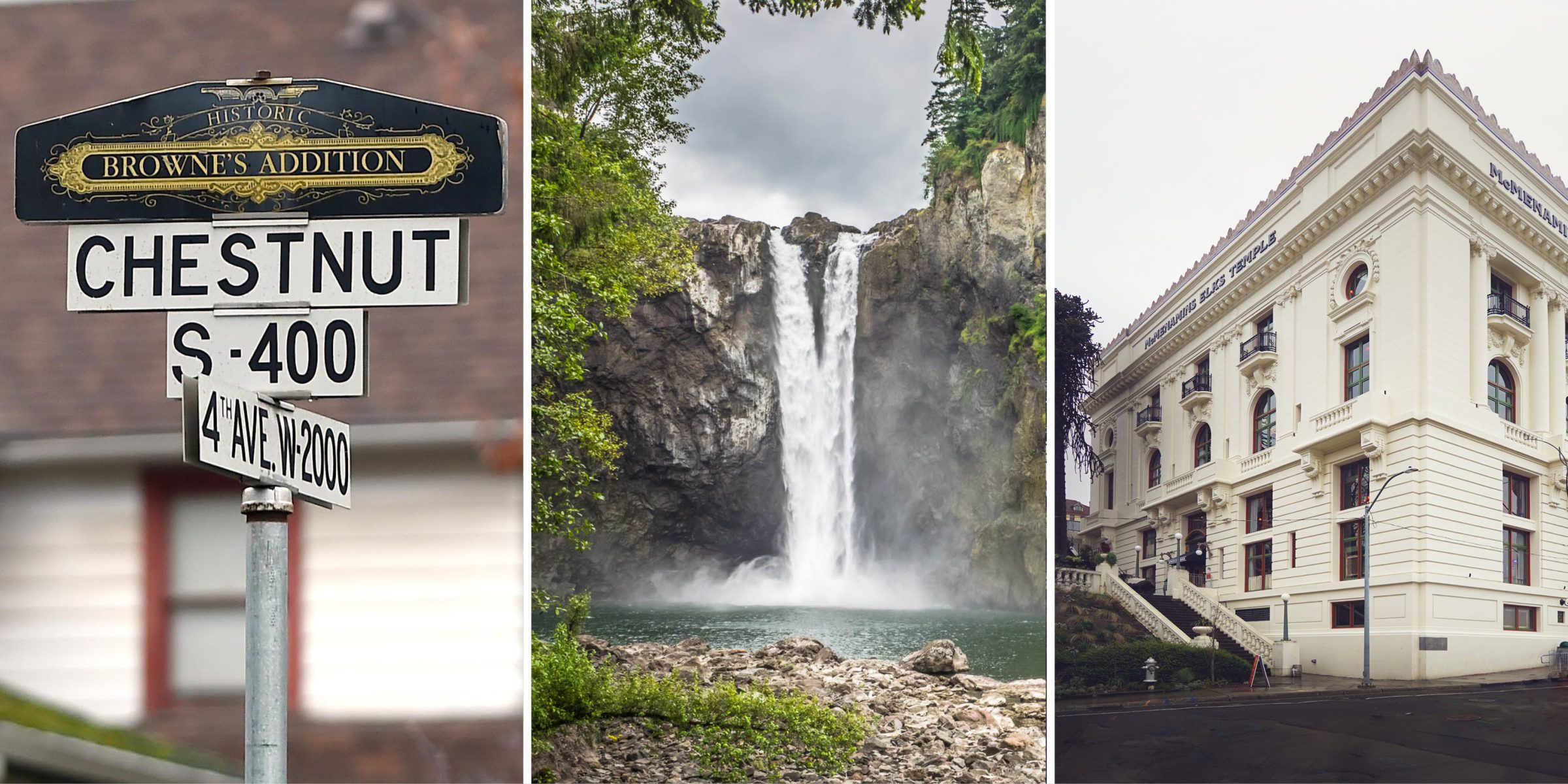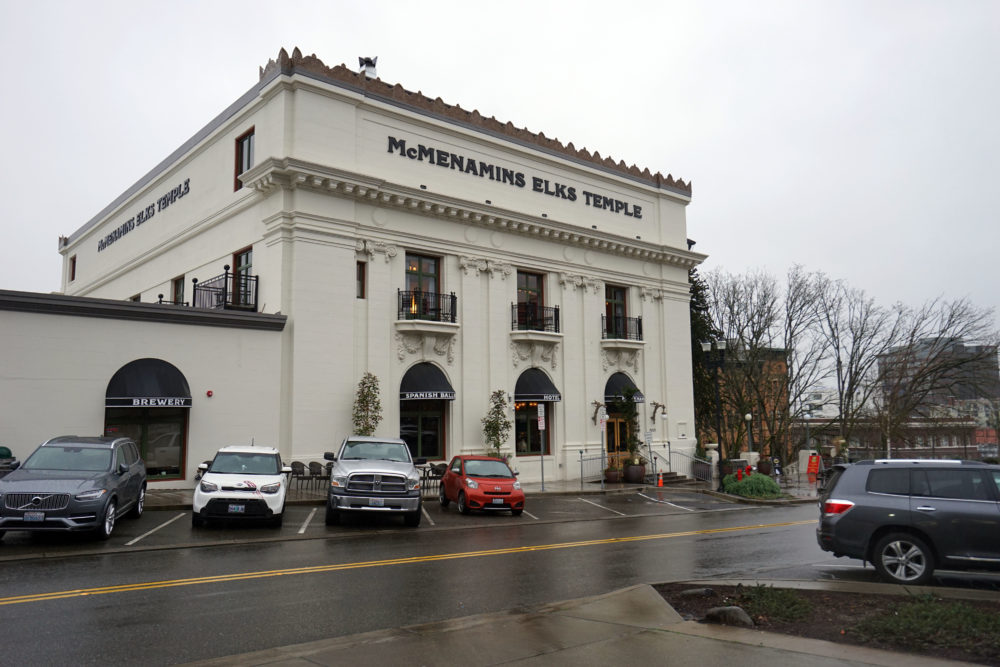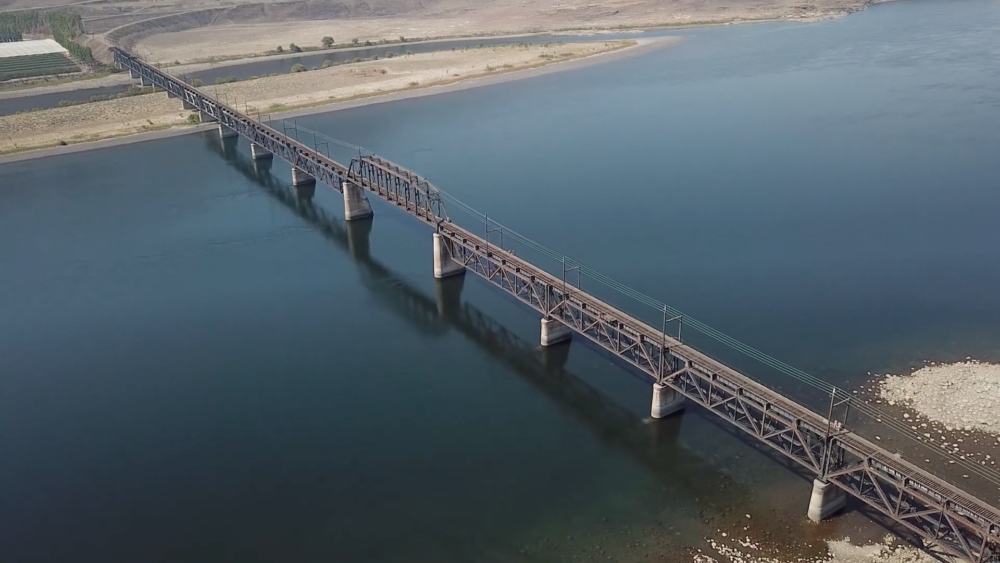Goldfinch Standard: Best Moments in Preservation From 2019

From left to right: Browne’s Addition in Spokane, Snoqualmie Falls in Snoqualmie, and the Louisa Hotel in Seattle.
Every year, the Washington Trust creates a list of the best moments in preservation, honoring exciting and inspirational preservation achievements from the previous year. In recent years—in (avian) counterpoint to Knute Berger’s “heritage turkeys” and in tribute to the goldfinch as the Washington state bird—we renamed our annual award winners the Goldfinch Standards. These are the stories that set the gold standard for preservation in Washington State, reminding us how vital the work of historic preservation and heritage stewardship remains.
Snoqualmie Falls Reclaimed by Snoqualmie Indian Tribe
In November of 2019, the Snoqualmie Indian Tribe announced that they purchased the Salish Lodge and Spa and the 45 acres surrounding Snoqualmie Falls for $125 million to prevent further development of the area. Snoqualmie Falls is the most important sacred site for the Snoqualmie Indian Tribe, and this acquisition will allow the Tribe to better negotiate with Puget Sound Energy (which currently operates two hydroelectric plants at the falls) as well as to share their story and the significance of the site. As Robert de los Angeles, Snoqualmie Tribal Chairman, wrote in The Seattle Times: “For the Snoqualmie Indian Tribe, Snoqualmie Falls and the surrounding area is home to the spirit of our people. It’s our birthplace of creation, the center of our people, and where Snoqualmie and other tribal ancestors have been buried for hundreds of generations…. For indigenous peoples, there is no separation of self and sacred lands…. Efforts have been made for generations to erase native people and our sacred sites, but we still find our strength from one another, our ancestors, and our many relatives through our sacred lands. We have always been here and will continue to thrive, as will our sacred lands through advocacy and actions. We are honored and excited to have the opportunity to invest in line with our tribal values and own our sacred lands and to be able to protect this area in perpetuity.”
Browne’s Addition Locally Protected
In early October, Browne’s Addition became Spokane’s first local historic district established by majority vote of property owners. This allows for all contributing buildings in the district to be protected by mandatory review rather than only some properties protected through voluntary management agreements with individual property owners. The new district will not only help prevent inappropriate development and demolitions, but also offers tax incentives to eligible properties for rehabilitation projects. The Washington Trust supported the City of Spokane code revisions in 2018 that made this process possible (one of our Goldfinch Standard honorees that year). The Washington Trust was pleased to highlight the new district type at a “Preservation 101” workshop we hosted in Spokane in conjunction with our Annual Members Meeting in October 2019. A special thanks to the many local partners who supported the ordinance, the establishment of the district, and our workshop, including the Browne’s Addition Neighborhood Council, the Spokane City/County Historic Preservation Office, and Spokane Preservation Advocates.
Building 9 at Sand Point
In 2019 at our annual fundraiser, Vintage Washington, we had the unique opportunity to showcase the adaptive reuse of the Sand Point Naval Air Station in Seattle’s Magnuson Park. In the late 2000s, the Washington Trust for Historic Preservation joined with community groups to advocate for the historic preservation of the campus, featuring it as a Most Endangered Place in 2009. Those advocacy efforts led to Sand Point’s designation as a historic district by the City of Seattle in 2011, making the Sand Point Naval Air Station Landmark District Seattle’s eighth historic district and the first one added in more than three decades. The shining achievement at Sand Point this past year was the rehabilitation of Building 9, the former Naval Enlisted Barracks. Built between 1929 and 1944, the building was continually added onto, as the air station grew, until it reached its current footprint of 224,000 square feet. In 2014, Mercy Housing Northwest acquired Building 9 and undertook a massive, multi-year rehabilitation project in partnership with Tonkin Architecture and Rafn Company. Mercy Housing Northwest has transformed the building into 148 much-needed units of affordable housing, community and supportive services spaces, an early learning education center, and a small health clinic. The finished building, which officially opened in August, has been rechristened Mercy Magnuson Place.
Funding for Washington Main Street
In April 2019, the Washington State legislature passed a budget that included increased funding for the Washington State Main Street Program nearly doubling the annual budget for this program. The Washington Trust credits the strong bipartisan support for Main Street in Washington State to several legislative champions and, significantly, to the advocacy efforts of local Main Street directors and their boards. Washington Main Street has grown its network tremendously in the nine years that it has been managed by the Department of Archaeology & Historic Preservation and the Washington Trust—a great thing for the state, but a challenge in terms of limited staff capacity to provide direct services. We are thrilled that this funding has allowed us to hire Jonelle McCoy as a second, full-time staff person dedicated solely to Main Street to work alongside program director Breanne Durham. We would like to extend our gratitude to all parties who have supported our mission and made these exciting developments possible.
Funding for the Beverly Bridge
Another major success from our Most Endangered Places list in 2019 was securing funding for the rehabilitation of the Beverly Bridge. Built in 1909, the former train bridge spans the Columbia River and is currently the missing link in a 285-mile-long recreational trail across the state. After its Most Endangered Places listing in 2017, the Washington Trust was able to play a unique role in managing mitigation funds directed toward the Beverly Bridge through the Section 106 process. With those funds, we initiated a rehabilitation study that provided enough information to enable the Washington State Department of Archaeology & Historic Preservation to make a request to the state legislature. Thanks to advocacy by the Washington Trust, the Palouse to Cascades Trail Coalition, and many other partners, the legislature approved $5.575 million in capital funding towards the rehabilitation and conversion of the Beverly Bridge for recreational use. Designs for the rehabilitation work are currently underway.
Louisa Hotel
The Louisa Hotel celebrated a grand reopening in June last year, with 85 workforce apartments and seven ground floor commercial spaces. It had been 50 years since anyone had lived in this 110-year-old hotel. The Woo family purchased the historic building in 1963 and opened Seattle’s first Chinese bakery, Mon Hei, on the hotel’s ground floor. On Christmas Eve of 2013, a fire severely damaged the building, initiating a project to save it, spearheaded by the next generation of the Woo family with help from another local family. The project exposed many historic artifacts—including the hotel’s original cash register, letters and telegrams, graffiti from World War II, 1920s Prohibition-era murals, and signs from the businesses located in the building in the 1930s. Many of these are now featured in the Louisa’s lobby, hallways, and community room. Utilizing both federal historic rehabilitation tax credits and Washington’s Special Tax Valuation Program, particular care was taken to preserve the building’s historic character while making critical seismic upgrades.
Tacoma Elks Temple Grand Opening
No look back at 2019 would be complete without acknowledging the Elks Building in Tacoma which opened this year as the McMenamins Elks Temple. The Washington Trust listed the building as one of our Most Endangered Places in 2003 in the midst of decades of neglect and an unsympathetic property owner. Community outcry combined with action from the City of Tacoma eventually prompted the purchase of the building by McMenamins in 2009. They secured the building until they were ready to begin construction in late 2017 and then opened to great fanfare on April 24, 2019. The building utilized federal historic rehabilitation tax credits as well as Washington State’s Special Tax Valuation Program. The reimagined building includes 45 guest rooms, multiple bars and restaurants (including al fresco dining on Tacoma’s iconic Spanish Steps), a music and events venue, and much more. With McMenamins’ eye toward weaving together art, local history, and their signature interior style, the Elks Temple has fast become a central community gathering place.
Main Street Now Conference in Seattle
In March 2019, in partnership with the National Main Street Center and the Department of Archaeology & Historic Preservation, the Washington Trust was thrilled to co-host the National Main Street Conference in Seattle and surrounding Main Street Communities. The conference drew over 1,800 participants from across the country, its highest attendance to date. In addition to spotlighting the Washington State Main Street Program, the conference was an excellent opportunity to showcase the innovation of Seattle’s urban neighborhoods and Main Street Communities throughout the region, with tours exploring whale-watching tourism and education on Whidbey Island, Japanese-American history on Bainbridge Island, and multicultural entrepreneurship in Kent, just to name a few.
Maritime Washington National Heritage Area
The story of Washington’s maritime history is key to understanding the broader development of the Pacific Northwest and the United States. For more than 10 years, the Washington Trust, along with Washington’s maritime heritage community, has advocated for designating Washington’s maritime resources as a National Heritage Area (NHA) stretching along Washington’s saltwater coastline from Grays Harbor County to the Canadian border. The National Heritage Area program is unique within the National Park Service. While NHAs are federally recognized through an Act of Congress, they are locally initiated, managed, and led by grassroots organizations. In February 2019, the long campaign for designation was finally realized when Congress passed the John Dingell, Jr. Conservation, Management, and Recreation Act, which included the establishment of the Maritime Washington National Heritage Area (MW-NHA). The Washington Trust has been named the local coordinating entity for the new NHA, and our task now is to develop a management plan, in partnership with local stakeholders, specific to the MW-NHA. Congratulations to everyone who has been involved in achieving the designation of our new National Heritage Area. And now, the real work begins; as we’ve said before—anchors aweigh!


McMenamins Elks Temple in Tacoma. Photo by Jennifer Mortensen.

An aerial view of the Beverly Bridge, spanning the Columbia River. Photo by Exeltech Consulting.
